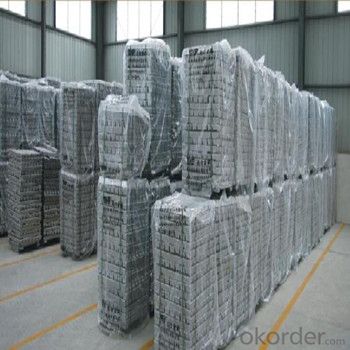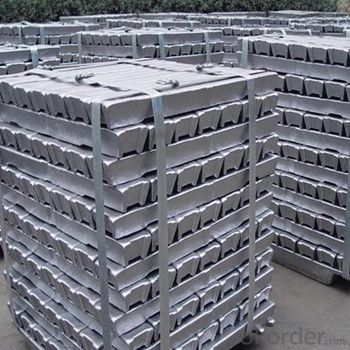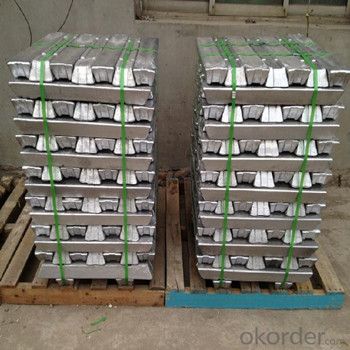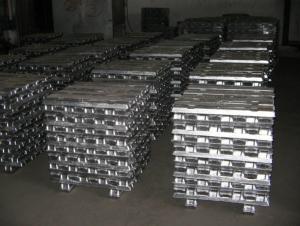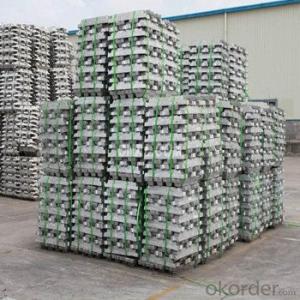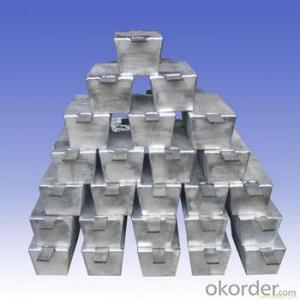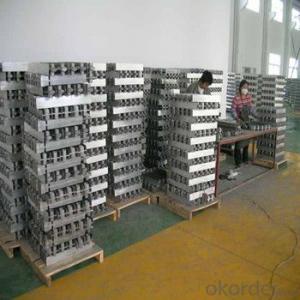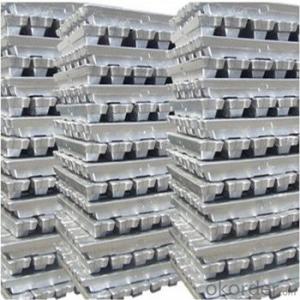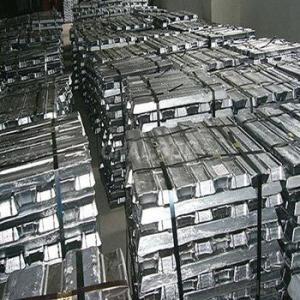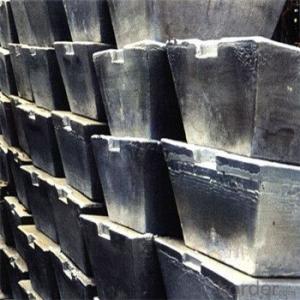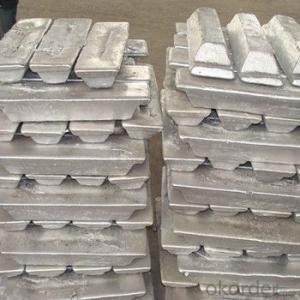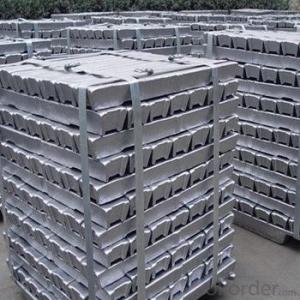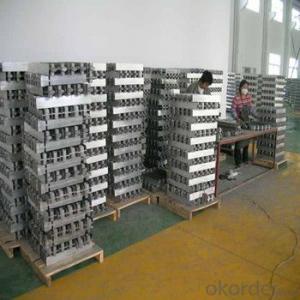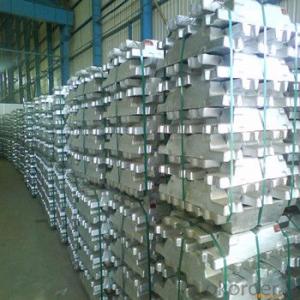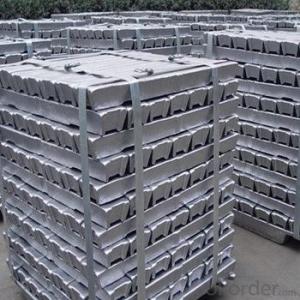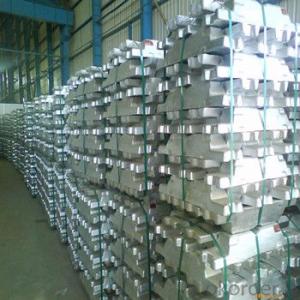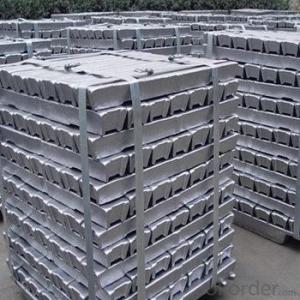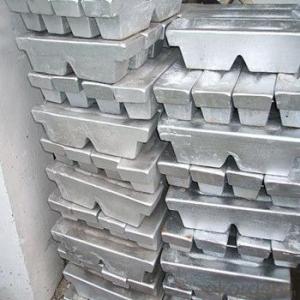Aluminum Pig/Ingot With 99.9% Putity For Selling
- Loading Port:
- China main port
- Payment Terms:
- TT OR LC
- Min Order Qty:
- 1000 m.t.
- Supply Capability:
- 100000 m.t./month
OKorder Service Pledge
OKorder Financial Service
You Might Also Like
Pure Aluminum Pig/Ingot Used for Industry
1.Structure of Aluminum Pig/Ingot
A material that has been cast into a shape in order to be transported and processed easier than in an unprocessed form. An ingot is typically rectangular in shape, which allows it to be stacked. Ingots are most commonly associated with metals, with ingots of gold held in the vaults of banks and brokerages being popular images.
Aluminum Ingot is with the AL as the main chemical composition.Aluminum Ingot is used for industry,such as automobile,pinning and weaving,electron broadly and so on. Aluminum Ingot has the following advantages: easy control and operation, fast melting.
2.Main Features of the Aluminum Pig/Ingot
•High Purity
•Easy control and operation
•High strength
•Fast melting
•Competitive price
•Best Service
3.Aluminum Pig/Ingot Images
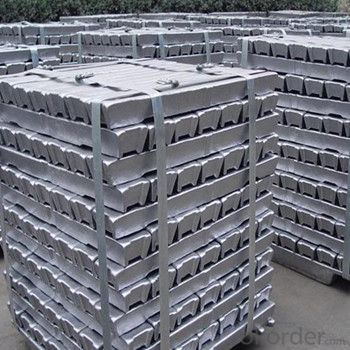

4.Aluminum Pig/Ingot Specification
Grade | Chemical Composition % | |||||||||
Al≥ | impurities ≤ | |||||||||
Si | Fe | Cu | Ga | Mg | Zn | Mn | others | Sum | ||
Al99.9 | 99.90 | 0.50 | 0.07 | 0.005 | 0.02 | 0.01 | 0.025 | - | 0.010 | 0.10 |
Al99.85 | 99.85 | 0.80 | 0.12 | 0.005 | 0.03 | 0.02 | 0.030 | - | 0.015 | 0.15 |
Al99.7 | 99.70 | 0.10 | 0.20 | 0.010 | 0.03 | 0.02 | 0.030 | - | 0.030 | 0.30 |
Al99.6 | 99.60 | 0.16 | 0.25 | 0.010 | 0.03 | 0.03 | 0.030 | - | 0.030 | 0.40 |
Al99.5 | 99.50 | 0.22 | 0.30 | 0.020 | 0.03 | 0.05 | 0.050 | - | 0.030 | 0.50 |
Al99.00 | 99.00 | 0.42 | 0.50 | 0.020 | 0.03 | 0.05 | 0.050 | - | 0.050 | 1.00 |
5.FAQ of Aluminum Pig/Ingot
We have organized several common questions for our clients,may help you sincerely:
①How about your company?
A professional factory which foucs on producing the aluminum pig,can meet customers' requiement to the quality and grade.The quality also have been accepted by customer.Already got the good reputation among the customers.It have gotten lot of much experience.The facrtory has the professional Technical Worker and the advanced equipments for production.Beside,it has the profesional teams to operate the whole proess for exporting.OEM service is availble and welcome.The items have beedn exported around the world,and have been acceptable among the customers,and have gotten the good reputation already.No matter from the quality,price and service,can be guaranteed for the cusgtomers.High purity and diffent grade are available.
②How to guarantee the quality of the products?
We have established the international advanced quality management system,every link from raw material to final product we have strict quality test;We resolutely put an end to unqualified products flowing into the market. At the same time, we will provide necessary follow-up service assurance.
③How long can we receive the prod rking days, We will arrange the factory delivery as soon as possible. The pecific time of receiving is related to the state and position of customers.Commonly 7 to 10 working days can be served.
- Q: What are the common defects found in aluminum ingots?
- Aluminum ingots may exhibit several common defects. Porosity is one such defect, characterized by the presence of small voids or air pockets within the ingot. It can arise from improper casting techniques or insufficient degassing of the molten aluminum. Porosity weakens the overall structure of the ingot and diminishes its mechanical properties. Another defect frequently observed is segregation, which arises when alloying elements or impurities are unevenly distributed within the ingot. This leads to variations in composition and properties across different sections of the ingot. Segregation can be caused by improper alloying or inadequate mixing of the molten aluminum. Cracking is yet another defect often encountered in aluminum ingots. It may occur during cooling or solidification if there is rapid or uneven cooling, resulting in thermal stress and cracking. Excessive hydrogen content in the aluminum can also induce cracking by promoting the formation of internal cracks. Furthermore, surface defects, including dross, oxide films, and inclusions, are commonly found in aluminum ingots. Dross refers to impurities and oxides that float on the surface of the molten aluminum and become trapped in the ingot during solidification. Oxide films form on the ingot's surface due to exposure to air or inadequate protection during casting. Inclusions are foreign particles or non-metallic compounds that get trapped within the ingot during solidification. These defects significantly impact the quality and performance of aluminum ingots. Consequently, it is critical to employ appropriate casting techniques, control alloy composition, ensure sufficient degassing, and implement effective quality control measures to minimize the occurrence of these defects.
- Q: How is the purity of aluminum ingots determined?
- The purity of aluminum ingots is determined through various analytical techniques and testing methods. One common method used is spectroscopy, specifically inductively coupled plasma optical emission spectroscopy (ICP-OES) or inductively coupled plasma mass spectrometry (ICP-MS). These techniques are capable of analyzing the elemental composition of the aluminum ingot, including the presence of impurities such as iron, silicon, copper, zinc, and others. Another technique employed is atomic absorption spectroscopy (AAS), which focuses on measuring the concentration of specific elements in the aluminum ingot. This method allows for the detection of trace impurities, as it is highly sensitive and selective for individual elements. Chemical analysis is also utilized to determine the purity of aluminum ingots. Acid digestion methods, such as dissolution in nitric acid or hydrochloric acid, are commonly used to dissolve the ingot and create a solution that can be analyzed for impurities. The resulting solution is then subjected to various tests, including titration, colorimetry, or gravimetric analysis, to quantify the impurities present. In addition to these techniques, physical testing methods can be employed to evaluate the purity of aluminum ingots. These methods involve measuring the physical properties of the ingot, such as density, melting point, or electrical conductivity. Deviations from the expected values can indicate the presence of impurities. Overall, determining the purity of aluminum ingots involves a combination of spectroscopic, chemical, and physical analysis techniques, allowing for a comprehensive assessment of the elemental composition and impurity levels in the ingot sample.
- Q: Can aluminum ingots be used in the production of musical instruments?
- Musical instruments can indeed be produced using aluminum ingots. Aluminum, a lightweight and adaptable metal, possesses various characteristics that render it suitable for musical instruments. Its malleability and ease of manipulation enable the crafting of intricate designs and intricate components. Moreover, aluminum's resistance to corrosion aids in preserving the instrument's quality and lifespan. Furthermore, aluminum boasts excellent resonant properties, resulting in the production of crisp and lively sound. To enhance performance and durability, numerous instruments like trumpets, flutes, and saxophones incorporate aluminum in their construction.
- Q: How much is a ton of aluminium ingot on the market?
- Anshan executive director and Secretary of the board of directors pay Kyrgyzstan will accept the inquiry said that Liaoning province is not affected by the snowstorm blowing, the Anshan Iron and steel production line is operating normally, although from Shanxi coal supply tensions, but from Heilongjiang normal supply, so the company can make proper deployment, to meet the needs. However, Fu Ji will say that the snow storm caused some traffic in the sales market to be confused and could not be paid on time.
- Q: What method does common smelting aluminium ingot adopt now?
- Look at what you are doing if scrap processing, processing of aluminum ingot aluminum products need to use a ton of coke 200-400 yuan, if the electricity is aluminum ore
- Q: What are the safety precautions when handling aluminum ingots?
- To prevent accidents and ensure the well-being of those involved, it is crucial to adhere to specific safety measures when dealing with aluminum ingots. Consider the following precautions: 1. Personal Protective Equipment (PPE): Always wear appropriate PPE, such as safety glasses, gloves, and protective clothing, to safeguard against potential hazards like sharp edges, splinters, or metal contact. 2. Proper Lifting Techniques: Given the weight of aluminum ingots, it is vital to utilize correct lifting techniques to avoid strains or injuries. Bend at the knees and lift with your legs, maintaining a straight back. If the ingot is too heavy, seek assistance or employ mechanical aids like cranes or forklifts. 3. Secure Storage and Handling: Store aluminum ingots securely to prevent rolling or falling. Stack them in stable piles, using appropriate stacking equipment if necessary. Avoid storing them near flammable substances or in poorly ventilated areas. 4. Fire Safety: Aluminum can ignite when exposed to high temperatures or sparks. Therefore, keep ingots away from open flames, sparks, or potential ignition sources. Additionally, ensure the availability of fire extinguishers in case of emergencies. 5. Hazard Awareness: Be conscious of the potential hazards associated with aluminum ingots, such as sharp edges, friction burns, or the risk of metal fumes. Take necessary precautions to avoid these risks, including wearing suitable gloves, utilizing tools with safety guards, or working in well-ventilated areas. 6. Training and Education: Ensure that individuals handling aluminum ingots receive adequate training and education regarding safe handling practices. This encompasses understanding potential hazards, proper equipment usage, and familiarity with emergency procedures. 7. Regular Inspections: Regularly inspect aluminum ingots for any signs of damage, such as cracks or sharp edges. Remove any damaged ingots from use, as they increase the likelihood of accidents or injuries. By adhering to these safety precautions, individuals can reduce the risks associated with handling aluminum ingots and foster a safer work environment.
- Q: What quality aluminium ingots can be made out of pop cans?
- In fact, the recycled aluminum slag can also be used for smelting aluminum ingots. But it doesn't work well. It needs stirring and a lot of slag. There is also a saying that the only way aluminum slag smelting aluminum ingot is electrolysis, the use of reduction method is too expensive
- Q: How can aluminum cans be made into aluminium ingots?
- First combustion in pure oxygen to produce three aluminum oxide two, and then three oxidation of two aluminum and iron combustion in the air replacement, the formation of iron oxide substances and aluminum elements, which is the required - aluminum ingot
- Q: What are the different finishing processes for aluminum ingots?
- Aluminum ingots can be subjected to various finishing processes to enhance their appearance, durability, and suitability for specific applications. Among these processes is anodizing, where the ingots are immersed in an electrolytic solution and an electrical current is passed through them. This generates an oxide layer on the surface of the ingot, which can be dyed to achieve different colors. Anodizing not only improves the ingot's aesthetics but also enhances its resistance to corrosion and durability. Another finishing process is powder coating, wherein a dry powder is electrostatically applied to the ingot's surface and then cured under heat to form a protective and decorative coating. Powder coating exhibits exceptional resistance to corrosion, chemicals, and UV rays, making it ideal for outdoor applications. Polishing is yet another technique employed on aluminum ingots, involving the mechanical rubbing of the ingot's surface with abrasive materials to create a smooth and shiny finish. This process effectively eliminates surface imperfections and scratches, resulting in a high-quality appearance. Painting is a widely used finishing process for aluminum ingots, entailing the application of a liquid paint coating onto the ingot's surface. Painting not only enhances the appearance but also provides protection against corrosion and environmental factors. Moreover, there exist other finishing techniques such as brushing, buffing, and sandblasting, which are utilized to achieve diverse surface textures and finishes on aluminum ingots. Ultimately, the choice of finishing process for aluminum ingots relies on the desired appearance, functionality, and intended application of the final product. Each finishing process possesses its own advantages and can be customized to fulfill specific requirements.
- Q: Who knows but also can do aluminium ingots what products?
- Because of the limitation of machinability, aluminum is generally suitable for casting, so the recycled aluminum is mostly in the form of ingotsSome parts can also be made into aluminium sheets or ingots for cold extrusion
Send your message to us
Aluminum Pig/Ingot With 99.9% Putity For Selling
- Loading Port:
- China main port
- Payment Terms:
- TT OR LC
- Min Order Qty:
- 1000 m.t.
- Supply Capability:
- 100000 m.t./month
OKorder Service Pledge
OKorder Financial Service
Similar products
Hot products
Hot Searches



